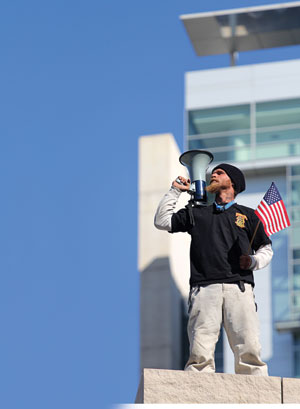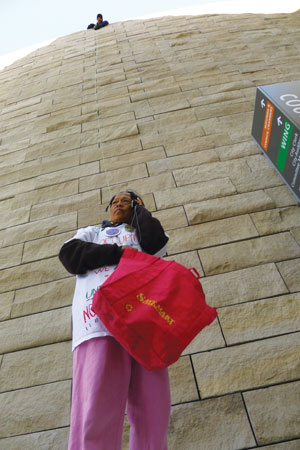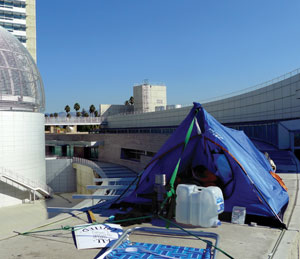Features & Columns
Postcards from the Ledge
now have some competition for the media's attention

"Just press this button and he'll be able to hear everything you say." I take the walkie-talkie and look upwards. Perched 36 feet above me, with legs dangling from the edge of a five-foot-wide concrete shelf, is 27-year-old Shaun O'Kelly. From this distance, I can make out a gritty smile through a scraggly blond goatee.
It has been a little more than two weeks since O'Kelly, known to his friends as Cracker, scaled a wall at San Jose's City Hall and sprang life back into the local occupation movement, which seemed to be losing its legs, overshadowed by the more mediagenic show 40 miles to the north. By taking the wall, the pierced and tattooed Jean-Paul Sartre-quoting high school dropout from the Gulf side of Northern Florida gave a face to the movement and kept San Jose on the map.
The nationwide campathon began Sept. 17 at Liberty Square in Manhattan, and thousands followed suit by assembling in cities from Boston to San Francisco. Even Mosier, Oregon, population 430, has an occupation movement, according to the website occupywallst.org. A small circle of Silicon Valley's students, unemployed and disenfranchised pitched several tents Oct. 2 in San Jose's municipal plaza.
Designed to draw attention to the influence of big banks and corporations on government, the Occupy Wall Street movement has sought to cast the American Dream as a mirage to most and a realization meted out to few.
Not everyone in the occupation movements will agree on each point, but the members' overall discontent unites them. And some government officials have sympathized with the occupation members' grievances.
But almost three weeks after Occupy San Jose was formed, Debra Figone, San Jose's city manager, directed police to arrest eight protesters in the early morning of Friday, Oct. 21. A city ordinance forbids people from camping on city property, and Figone suggested the decision was made because of health and safety issues.
Whether it was fatigue from sleeping on the sidewalk, a lack of company in the cold night or anonymous death threats, which at least one outspoken female member received, the occupation in San Jose was noticeably dwindling in bodies and enthusiasm as the arrests started.
And then Cracker went climbing.
 UNDERDOG, HIGHER UP: As the rich get richer, Cracker's scaling of a 36-foot wall has elevated the prominence of the issue locally.
UNDERDOG, HIGHER UP: As the rich get richer, Cracker's scaling of a 36-foot wall has elevated the prominence of the issue locally.
Spending time in preparation at Mt. Shasta to overcome his fear of heights, he says, O'Kelly climbed the 36-foot plaza wall in the early morning hours of Monday, Oct. 24, with the help of some mounted trashcans. That same day, four more Occupy San Jose protesters were arrested. Throughout the rest of the week, hundreds more were arrested or forcibly removed from occupation sites throughout the country, no more noticeable than in the violent clashes with police in Oakland's Frank Ogawa Plaza, renamed Oscar Grant Plaza by occupiers.
Were it not for O'Kelly's actions, it's quite possible the Occupy Wall Street movement would have only two homes in the Bay Area: San Francisco and Oakland. Fifteen people in San Jose have been arrested and 28 have been cited, according to police, and Cracker was the first on both counts.
"I've had people go as far as to say I am Occupy San Jose," O'Kelly says through the walkie-talkie, taking drags off a cigarette as he looks down from the wall. "I don't necessarily think that's true. There might not be the tents that there are down there today, but it would still be in people's mindsets and there would still be people out on the corners holding signs."
Maybe. Maybe not. But no one in San Jose has been as bold as Cracker. Police refuse to bring him down for fear that officers or O'Kelly could suffer injuries or worse from a fall. "They definitely don't want anyone to get hurt and I don't want to get hurt," O'Kelly says. "But there's really no safe way they could force me down from here."
"My understanding is he claims to be a mountaineer, which I'm grateful for," says Chris Moore, San Jose's police chief. "You don't want to see people walking around at those heights."
A short list of occupation grievances is anything but that. However, a common theme is combating the assault taking place by the haves against the have-nots. According to a recently drafted 99 Percent Declaration, which is pushing for a National General Assembly to mobilize the movement in advance of the 2012 presidential election—similar to the Tea Party in the 2010 mid-term elections—there are 21 items that must be addressed. They include: the abrogation of the "Citizens United" Supreme Court ruling, which by a 5-4 vote gave corporations "protected free speech"; a not-for-profit healthcare system; stricter environmental laws; student loan reform; banking and securities reform; and higher taxes for the wealthy.
"For the general population—the 99 percent in the imagery of the Occupy movement—it's really harsh and it could get worse. This could be a period of irreversible decline," writes leftist stalwart Noam Chomsky, an enthusiastic Occupy Wall Street supporter. "For the 1 percent, or furthermore 1/10th of 1 percent, it's just fine. They're at the top, richer and more powerful than ever in controlling the political system and disregarding the public, and if it can continue, then sure why not?"
In his first days on the wall, O'Kelly demanded a meeting with the mayor and city manager that would allow Occupy San Jose members to air all their grievances inside City Hall in return for his removal. The city considered his ransom demand. But Tom Manheim, communications director for the city, says it soon became clear that Cracker was only seeing how far the city would cave.
"We tried to arrange a phone call," Manheim says. "Then it changed; he didn't want to talk to [Figone]. It became clear that he wasn't really interested in talking with her. He was trying to create a showcase."
Media outlets around the Bay Area as well as the Associated Press have spread word of San Jose's lone protester on an elevated perch, and Facebook and Twitter have amplified the reach exponentially. But there is irony to Cracker's situation. In his attempt to hold the city hostage he acknowledges that he is also holding himself hostage.
"If City Hall starts working with us, I would agree to come down," O'Kelly says. "But they're not going to issue us a permit [to camp at City Hall overnight] until I come down, and that wouldn't be fair to the team that I'm a part of. But I can't stay up here forever and 99 days sounds like a pretty great number."
After those 99 days, members of the street-level occupation, who move their tents across the street from City Hall at night to avoid citations and arrest, say they'll continue. What role Cracker will play following his descent—he will assuredly be arrested, according to police—is undetermined.
"We'll see how he feels when he comes down," says Alicia Rice, a 24-year-old occupation member who splits her time working in a coffee shop and contributing to the cause through volunteer work and documenting the movement on film. "But it's not about stopping. If he comes down, it's not the end of the movement."
The truth, though, is O'Kelly has already come down. City officials and police were stunned to learn that Cracker secretly left his perch briefly last weekend to spy on the ground-level proceedings before scaling the wall again before anyone was the wiser.
"I would love to know what day that was," Moore says. "We can't be there 24 hours a day."
O'Kelly's resolve has been sustained through the help of fellow occupation members, who send up food, water and other supplies on a rope that he pulls up the wall. There is a space near the back of the table-top that he uses as shelter to dispose of bodily functions in a bag. It's not an easy or glamorous life, especially as the weather turns cold, but O'Kelly's life hasn't been straightforward from the start.
"I never made it out of 10th grade," he says. "The only reason I made it through ninth grade is because I was in a juvenile prison at the time and I had to go to school."
Cracker says he has private financiers who have offered to post his bond if and when arrested, but he doesn't expect rough treatment when his stand comes to an end.
"All the contact I've had with police, even before I came up here, they were very pleasant," O'Kelly says. "The police were very respectful. They weren't trying to give us any more trouble than they were forced to give us. Some of the city officials—there was one lady in particular who was really a hard ass about being up here, but I've had some good conversations with the city."
So, where did Cracker come from? And how long has he lived in San Jose?
"I've been living everywhere, if you ask me," he says.
 LOCATION, LOCATION, LOCATION: Cracker's makeshift home features the essentials of any occupier.
LOCATION, LOCATION, LOCATION: Cracker's makeshift home features the essentials of any occupier.
Surprise Squatter
Joining some friends in Hollywood, Shaun O'Kelly came to California a little less than a year ago. An unknown with few connections, he would last only a week in the city best known for its celebrities. Joining a friend and his girlfriend, O'Kelly climbed into a car the day after Thanksgiving and came to San Jose, where he has taken turns living with friends and on the streets.
It was the kind of impulsive act that seems to have defined O'Kelly's life and made him friends as well as enemies. And while he wouldn't call law enforcement the enemy, Cracker also wouldn't say they've always been on the friendliest of terms.
With a "pretty extensive juvenile record," O'Kelly, who grew up in Florida, says he has been in jail more times than he can count, for everything from failure to appear on warrants to disorderly conduct to beating up a man outside of a bar in front of police. The evening he spent in jail after police hauled him away from the San Jose City Hall plaza "was the shortest stay in jail I've ever had," he says.
Growing up in Crystal River, Florida—about 90 minutes from Tampa—O'Kelly says he and his family moved to a cattle ranch near Lake Okeechobee when he was 8. Later on he moved to Fort Myers, where he found most of his trouble, picked fights, dropped out of school and found refuge in bars and local libraries.
"I remember there was a week where I was trying to stay away from my friends because they pissed me off," he says. "So I would go to a bar and have a couple drinks and then go to the library and read The Universe in a Nutshell."
And that, in a sense, is Cracker in a nutshell. He is serious but self-deprecating, thoughtful yet untamed; he has a tattoo on his neck, piercings in his lower lip and septum and holds his hands in the shape of a heart to passersby.
The complexity of his character at times mirrors the alternately unified and fractious movement he joined. No one is so bold at any of the Occupy Wall Street movements to claim a leadership position. Instead, many choose to passively coordinate at the risk of letting the message against financial inequalities and government corruption be hijacked by vandals, drug peddlers, unions and various others seeking attention.
Cracker is the biggest star of Occupy San Jose and yet he has little involvement in the general assembly meetings below him, which fluctuate in attendance from a few dozen to more than one hundred and now take place twice a week.
"Not being able to help out with some of the disputes on the ground is the toughest part," says O'Kelly, whose blue tent serves as living quarters. Boredom isn't uncommon, and he spends much of his time meditating and reading as well as walking back and forth on the wall for exercise. He has talked about setting up a garden where he can grow industrial hemp. "I feel like I'm not really doing much up here. But everyone says just by me being up here I'm doing a lot by inspiring people."
The same could be said about another Bay Area protester who has become a symbol of the resistance, although less for his actions than what happened to him. When Scott Olsen, a 24-year-old Iraq war veteran, was seriously injured in the Occupy Oakland protests two weeks ago—by a police tear gas canister—he became the face of a people suppressed.
"Scott Olsen is my hero, for sure," says O'Kelly, who has been able to keep tabs on other occupations by using a laptop that is periodically sent up the wall. "I hate to say it couldn't have happened to a better person, but the fact that it happened to a two-time Iraq war vet, they really screwed up that time."
The scores of people injured and arrested in Oakland, which has become the epicenter of the worldwide occupation movement, only underscores what has been conspicuously lacking in San Jose, the 10th largest city in America. The SJPD has had so few problems with protesters here by comparison, that 20 officers on motorcycles were dispatched to Oakland for crowd control the night Olsen was injured.
Nailing down why San Jose's move-ment has been so docile is a lesson in history, says Police Chief Moore
"Part of it has to do with where we are in Silicon Valley, compared to Oakland and its proximity to Cal-Berkeley and San Francisco, which has a robust history of public protest," he says. "We've never really had that here in San Jose. A lot of people might be inclined to go up there."
O'Kelly says he is proud of his "brothers and sisters" in San Jose, but he admits he would like to see more participation in protests here, especially when watching what's happening in the East Bay.
"The things that are going on in Oakland, there really is no comparison to San Jose. We don't have the numbers. We haven't had the confrontations with the police," O'Kelly says. "But the important thing is we're doing something now. We're not just bending over and taking it anymore."
And that, it seems, is all Occupy San Jose can ask for at the moment. There likely won't be mass marches that collide with cops in riot gear, rubber bullets, tear gas canisters or flash grenades.
"One of the best things to come out of this is that it gave me a solid notion that I've changed this world," O'Kelly says. "I got a cupcake from an elementary/middle school last week. It had an eyeball on top of it. And the kids said they had their eye on me, because they would have never known any of these things were going on unless they saw me on TV and asked their parents.
"I haven't been able to cry in quite a long time, but the Saturday before this, I cried myself to sleep with tears of happiness. I know it sounds like one of those movies, but I really felt like I've touched people. It's an incredible and powerful sensation."


